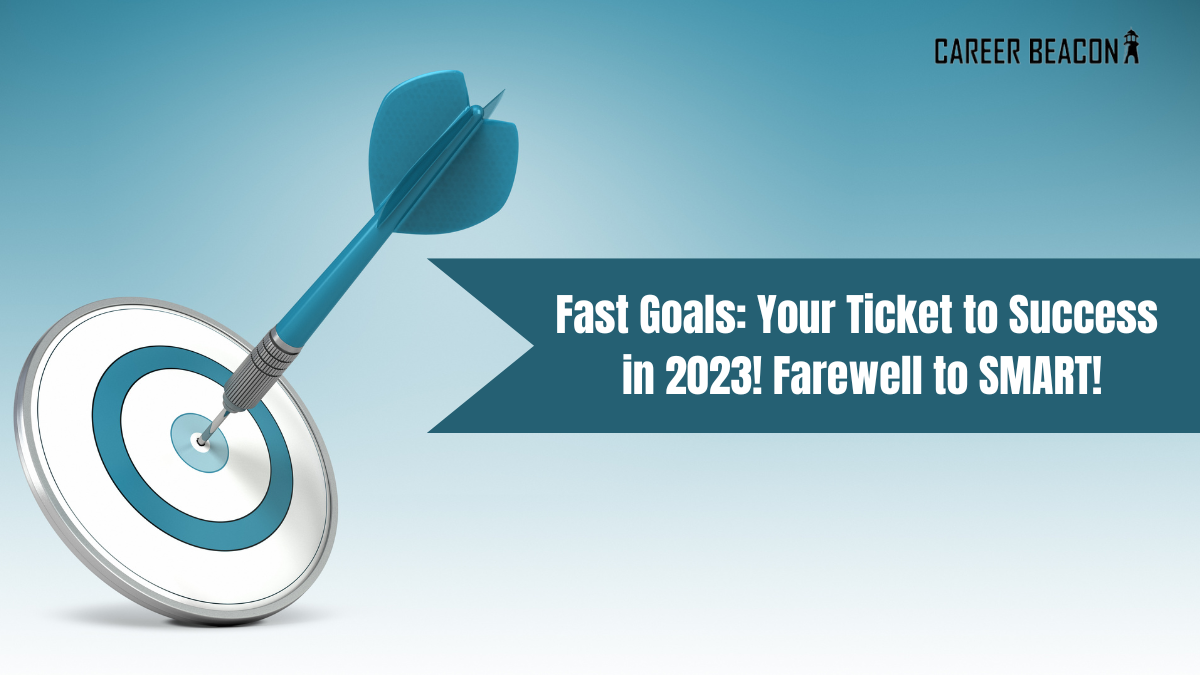
Fast Goals: Your Ticket to Success in 2023! Farewell to SMART!
Are you tired of setting goals that seem to drag on forever, leaving you uninspired and unmotivated? Well, it’s time to bid farewell to the outdated SMART goal-setting method! Say hello to a revolutionary approach tailored for the modern world – FAST goals.
Bursting with energy, ambition, and a dash of creativity, FAST are here to transform how we dream big and achieve even bigger. Get ready for an exhilarating ride as we embark on this journey together in redefining success and unleashing our full potential.
Are you up for the challenge? Let’s dive into the exciting realm of FAST and unlock new levels of accomplishment like never before!
What are SMART Goals?
The SMART goal setting framework is one of the most popular and widely used tools for goal setting. However, there is a growing body of evidence that suggests that SMART goals may not be as effective as they are often claimed to be.
The main problem with SMART goals is that they can lead to a narrow focus and an overemphasis on specific details, which can ultimately limit creativity and innovation. Additionally, SMART goals can often be too rigid, making it difficult to adapt to changing circumstances.
In contrast, FAST – Frequently discussed, Ambitious, Specific, and Transparent. This dynamic approach is tailor-made to conquer the challenges of an ever-shifting landscape. are designed to address the shortcomings of SMART goals. FAST are intended to be more flexible and adaptable, while still being specific and time-bound.
Overall, these goals are a more modern and effective approach to goal setting than the traditional SMART goal framework.
Why SMART Goals are Becoming Less Relevant in the Modern World
There are a few reasons why SMART goals are becoming less relevant in the modern world. First, the traditional workplace is changing. More and more people are working remotely or in nontraditional environments, which makes it harder to measure things like productivity and progress. Second, the goals themselves are often too specific and inflexible to be truly effective.
A goal that is too specific can be limiting and make it difficult to adapt to changes or unforeseen circumstances. Many people find that SMART goals are simply not motivating. The rigidity of the system can make it feel like a chore, which defeats the purpose of setting goals in the first place.


FAST are designed to be more flexible and adaptable, so that they can better meet the needs of today’s workers. They are also specific enough to be measurable, but not so specific as to be inflexible. And finally, FAST are time-bound, so that you can track your progress and see how close you are to achieving your goal.
Introducing FAST Goals
Setting and achieving goals is a key part of success in any area of life. But the traditional SMART goal setting method is no longer fit for purpose in the modern world. That’s why it is a – a new, more effective way to set and achieve your goals.
FAST have emerged as a dynamic alternative to traditional goal-setting methods like SMART goals. In a rapidly changing and unpredictable world, FAST (Frequently discussed, Ambitious, Specific, Transparent) goals offer adaptability and agility. By encouraging regular discussions, setting ambitious yet achievable targets, maintaining clarity, and ensuring transparent progress tracking, These goals empower individuals and organizations to navigate the complexities of the VUCA (volatile, unpredictable, complex, and ambiguous) environment. Embracing this fosters a high-performance culture, enabling continuous improvement, innovation, and success in the face of uncertainty.
The beauty of it is that they can be used in any area of your life – from your career to your personal life and everything in between. So what are you waiting for? Start setting some FAST today!
How to Set FAST Goals
Setting FAST involves a systematic approach to ensure they are effective and aligned with the principles of the FAST framework. Here’s a step-by-step guide on how to set:
-
Understand the Purpose: Clearly define the purpose and desired outcomes of the goals. Understand why these goals are essential for personal or organizational growth and how they align with broader objectives.
-
Identify Key Areas: Determine the critical areas or aspects where setting goals will make the most significant impact. Focus on key results that contribute to overall success.
-
Make Goals Frequently Discussed: Ensure that goals are regularly discussed among relevant stakeholders. Schedule meetings or check-ins to review progress, identify challenges, and recalibrate when necessary.
-
Set Ambitious Yet Achievable Targets: Define goals that challenge you or your team to reach higher levels of performance while ensuring they remain realistically achievable. Aim for a balance between ambition and feasibility.
-
Be Specific and Measurable: Make your goals specific and well-defined. Use clear metrics to measure progress and success. This ensures that everyone involved knows exactly what needs to be accomplished.
-
Foster Transparency: Share goals and progress openly among team members and stakeholders. Transparency promotes accountability and encourages collaboration.
-
Break Goals into Actionable Steps: Divide each goal into smaller, actionable steps. This allows for better planning and makes the path to achievement more manageable.
-
Align Goals with Values and Objectives: Ensure that your goals align with your values, long-term objectives, and the overall mission of the organization.
-
Monitor Progress and Celebrate Success: Continuously track progress towards goals. Celebrate milestones and achievements to boost morale and motivation.
-
Be Adaptable: Embrace change and be prepared to adjust goals as circumstances evolve. Fast-paced environments require flexibility and adaptability.
-
Provide Support and Resources: Ensure that individuals or teams have the necessary resources, tools, and support to pursue their FAST effectively.
-
Review and Learn: Regularly review the effectiveness of your FAST. Learn from both successes and setbacks to continually improve the goal-setting process.
By following these steps, you can effectively set FAST that empower you or your organization to thrive in a dynamic and ever-changing world, fostering a culture of high performance and adaptability.
Benefits of Using FAST Goals
When it comes to setting and achieving goals, the old adage of ‘SMART goals’ no longer applies in the modern world. SMART goals are specific, measurable, attainable, realistic, and time-bound. However, this outdated method doesn’t take into account the ever-changing landscape of the business world.
FAST are a more effective way to set and achieve goals in today’s business environment. FAST are flexible, adaptable, specific, measurable, and time-bound. Here are some of the benefits of using FAST :
1. They’re more flexible than SMART goals.
In a rapidly changing business environment, it’s important to have goals that are flexible enough to adapt to change. That’s where FAST come in. With FAST, you can make changes as needed without having to start from scratch.
2. They’re more specific than SMART goals.
With goal setting, you’ll be able to zero in on what you want to achieve much more quickly and easily than with SMART goal setting. This is because FAST setting forces you to be clear about what you want to achieve from the start.
3. They’re just as measurable as SMART goals.
Measuring progress is an important part of any goal-setting process. With goal setting, you can measure progress just as easily as with SMART goal setting.
Examples of FAST Goals
The FAST system is designed to help you achieve your goals in a more efficient and effective way. Here are some examples of FAST that you can use to get started:
For Freshers/Students:
-
Improve Time Management Skills:
- Frequently discussed: Regularly meet with a mentor or coach to track progress and receive feedback on time management practices.
- Ambitious: Aim to effectively manage time to balance academics, extracurricular activities, and personal life.
- Specific: Reduce time wasted on distractions by implementing a daily schedule and prioritizing tasks.
- Transparent: Share the time management plan with mentors or study groups for accountability.
-
Obtain Internship Placement within 2 Months:
- Frequently discussed: Attend career counseling sessions and networking events regularly to explore internship opportunities.
- Ambitious: Strive to secure a valuable internship experience aligned with career goals.
- Specific: Secure an internship offer within two months from targeted companies or industries.
- Transparent: Share progress and application status with mentors or career advisor.
3. Employees can use FAST to drive their progress in the following way:
-
Frequently discussed: Engage in regular conversations with managers or mentors to review progress, seek feedback, and make necessary adjustments.
-
Ambitious: Set challenging yet achievable goals that inspire personal growth and development.
-
Specific: Define clear and well-defined objectives that outline the desired outcomes.
-
Transparent: Share goals and progress openly with relevant stakeholders for support and accountability.
By adopting FAST , employees can foster a high-performance mindset, track their advancement effectively, and take ownership of their professional development journey.
Conclusion
These offer a more flexible and adaptable approach to goal setting that fits our modern, fast-paced world. They are easy to understand and provide an effective framework for breaking down your ambitions into manageable chunks.
With the principles of Frequently discussed, Ambitious, Specific, Transparent Goals in mind you can take control of your life and strive towards achieving the success you always dreamed of. So why not start developing your own FAST goals today?



